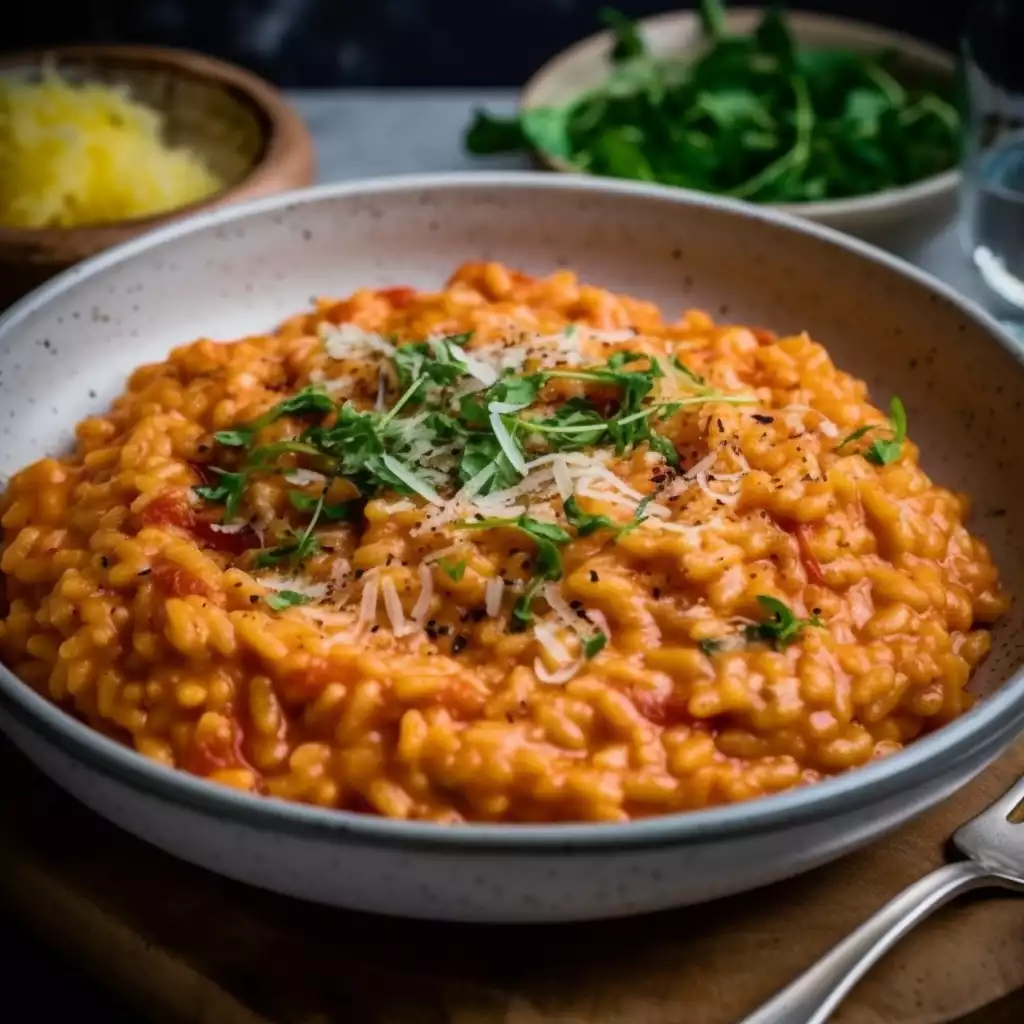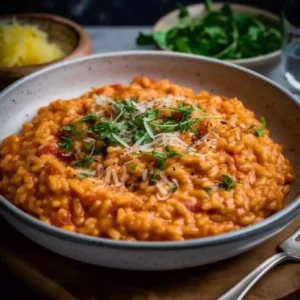
Tomato Risotto, a dish as vibrant and rich in history as it is in flavour, stands as a testament to the versatility and enduring appeal of Italian cuisine.
Originating from the North of Italy, risotto traditionally involves rice cooked to a creamy consistency using broth. What makes the Tomato Risotto unique is its incorporation of tomatoes, adding a refreshing twist to the classic dish.
The beauty of risotto lies in its simplicity and adaptability. While the traditional recipe often calls for white wine and a variety of meats or vegetables, the Tomato Risotto takes a more straightforward, plant-based approach. This dish is perfect for those looking for a comforting meal that’s not too challenging to make.
The process, requiring constant stirring and attention, transforms the simple Arborio rice into a creamy, flavour-packed delight. It’s a task that, while a bit time-consuming, is far from difficult and certainly worth the effort.
What’s fascinating about Tomato Risotto is the myriad of variations it inspires. From adding different types of cheese to incorporating various herbs, each alteration can significantly alter the dish’s flavour profile. Some cooks enjoy adding a splash of red wine for a deeper taste, while others might experiment with different types of tomatoes, such as sun-dried or cherry tomatoes, for an interesting texture and taste contrast.
The use of Arborio rice is crucial to achieving the perfect risotto. Its high starch content and ability to absorb liquids give the dish its signature creamy texture without the need for cream.
As for the tomatoes, they not only add a beautiful colour but also provide a tangy contrast to the rich, creamy rice. The inclusion of basic ingredients like onions and garlic lays a flavourful foundation, while herbs like basil and oregano introduce an aromatic depth.
In terms of difficulty, Tomato Risotto is surprisingly forgiving. The key lies in patience and attention during the cooking process.
The technique of adding broth gradually and stirring constantly allows the rice to release its starches slowly, resulting in a creamy texture. It’s a process that might seem daunting to beginners but is, in fact, quite straightforward and highly rewarding.
As for serving, Tomato Risotto is often garnished with Parmesan cheese and fresh basil leaves. These toppings not only add an extra layer of flavour but also enhance the visual appeal of the dish. The cheese adds a salty, umami touch, while the basil brings a fresh, herbaceous note, making each bite a delightful experience.
Tomato Risotto is more than just a meal; it’s a journey through the rich landscape of Italian culinary tradition. It’s simple ingredients, combined with a bit of time and love, result in a dish that’s comforting, satisfying, and capable of bringing a small piece of Italy to your table.
Whether you’re a beginner or an experienced cook, this recipe is a wonderful addition to your culinary repertoire, promising a delicious and rewarding experience with every spoonful.
Expert Tip: For the perfect creamy texture, stir your risotto frequently. This constant movement helps release the starch from the Arborio rice, resulting in a smoother, creamier dish.
It’s important to understand that each ingredient plays a specific role in creating the dish’s unique flavour and texture. From the creamy Arborio rice to the tangy tomatoes, every ingredient contributes to the overall success of this classic Italian dish.
Arborio Rice: Arborio rice is the backbone of any risotto. Its high starch content is key to achieving the creamy texture that risotto is known for.
When cooked slowly and stirred often, the rice releases its starches, resulting in a creamy, velvety dish without needing any actual cream. If you can’t find Arborio rice, Carnaroli or Vialone Nano are excellent substitutes, though they may slightly alter the texture.
Onion: Onions are essential in this recipe as they provide a subtle sweetness and depth of flavour. They are the starting point of the dish, sautéed until translucent to create a flavour base that enhances the other ingredients.
If you’re looking for an alternative, shallots can be a good substitute, offering a milder and slightly more refined flavour.
Garlic: Garlic adds a punch of flavour, giving the risotto a depth of taste with its aromatic and slightly spicy notes. It’s crucial not to overcook the garlic to prevent bitterness. If you’re not a fan of garlic, you can reduce the amount or omit it, but it does contribute significantly to the overall flavour profile.
Canned Tomatoes: Canned tomatoes are used in this recipe for their convenience and consistent flavour. They add a lovely acidity and moisture to the risotto, balancing the richness of the rice and cheese. Fresh tomatoes can also be used when in season, but they should be ripe and juicy for the best result.
Vegetable Broth: The broth is what cooks the rice and infuses it with flavour. Vegetable broth keeps the dish vegetarian-friendly, but you can also use chicken or beef broth for a different flavour profile.
The key is to add the broth gradually and keep it warm, allowing the rice to absorb it slowly and release its starches.
Olive Oil: Olive oil is used for sautéing the onions and garlic, providing a rich and fruity base flavour. It’s a staple in Italian cooking and contributes to the dish’s overall Mediterranean feel. If you prefer, you can use butter for a richer taste, or a different vegetable oil if you’re looking for a lighter option.
Dried Basil and Oregano: These herbs add an aromatic quality to the dish, bringing in notes of sweetness and slight bitterness. They complement the tomatoes beautifully. Fresh herbs could be used as an alternative, but they should be added towards the end of cooking to preserve their flavour.
Salt and Pepper: These seasonings are crucial for enhancing all the other flavours in the dish. They should be used to taste, keeping in mind that the Parmesan cheese will also add saltiness.
Parmesan Cheese: Parmesan adds a nutty, salty flavour that rounds out the dish. It also contributes to the creamy texture. For a vegan option, nutritional yeast or a vegan Parmesan alternative can be used.
Fresh Basil Leaves: Fresh basil provides a burst of freshness and colour, contrasting the rich, creamy risotto. It’s more than just a garnish; it adds an essential fresh and herbaceous element to the final dish.
By understanding the role of each ingredient in Tomato Risotto, you can better appreciate the harmony of flavours and textures in this beloved Italian dish.
Expert Tip: Don’t rush the cooking process. Adding broth slowly and allowing it to be absorbed before adding more is key to developing the risotto’s flavour and texture.
While Arborio rice is ideal for risotto due to its high starch content and ability to absorb liquids while remaining al dente, there are alternatives. Carnaroli and Vialone Nano are excellent substitutes, offering a similar creamy texture. In a pinch, a short-grain rice like sushi rice can be used, though the texture and flavour will differ slightly from traditional risotto.
Absolutely! To make Tomato Risotto vegan, simply substitute the Parmesan cheese with a vegan alternative or nutritional yeast, which offers a similar cheesy, umami flavour. Ensure that the vegetable broth you’re using is also vegan-friendly.
Yes, fresh tomatoes can be used in place of canned, especially when they are in season and at their peak of flavour. Opt for ripe, juicy tomatoes to achieve a similar consistency and taste to the canned variety. The cooking process might need slight adjustments, as fresh tomatoes may release more or less liquid than their canned counterparts.
The key to perfect risotto is its texture. It should be creamy, with each grain of rice retaining a slight bite, or ‘al dente’. The whole cooking process usually takes about 18-20 minutes after adding the rice. Taste testing towards the end of cooking is the best way to check for doneness.
Risotto is best enjoyed fresh, but leftovers can be reheated. Add a little broth or water when reheating to revive its creamy texture, as it tends to thicken when cooled. Reheat it slowly on the stove, stirring frequently. Avoid microwaving if possible, as it can unevenly heat and change the texture of the risotto.
Preparing risotto ahead of time can be tricky, as the dish is best when served fresh. However, if you need to prep in advance, cook it until it’s slightly less than al dente and cool it quickly. Before serving, reheat the risotto slowly, adding a bit of broth to loosen it up and finish the cooking process. This method helps retain the creamy texture and flavour.
Tomato Risotto is a hearty dish on its own, but it pairs beautifully with a variety of sides. A simple green salad dressed with olive oil and lemon juice can offer a refreshing contrast. For a heartier meal, serve it alongside grilled vegetables, chicken, or fish. A crusty piece of bread also complements the creamy texture of the risotto well.
Leftover Tomato Risotto should be stored in an airtight container in the refrigerator and consumed within two days. A popular way to use leftover risotto is to make arancini — fried risotto balls stuffed with cheese. Simply form the chilled risotto into balls, insert a small piece of mozzarella in the center, coat in breadcrumbs, and fry until golden. This transforms your leftovers into an entirely new and delicious dish.
Expert Tip: Experiment with garnishes to elevate your Tomato Risotto. Fresh herbs, a drizzle of good quality olive oil, or a sprinkle of chilli flakes can add an extra dimension of flavour and make the dish more visually appealing.
Here are some more recipes for you to enjoy! If you my recipes don’t forget to rate and leave a comment.
If you have any recipe suggestions, please do not hesitate to ask me. A great way to stay in contact with me is through Instagram, Facebook, Twitter and YouTube. Don’t forget to tag me @CookwithNabeela in your recipe photos!

Subscribe now to receive my latest recipes directly in your inbox. Stay up-to-date and never miss out!

I love to cook! I want to share with you my favourite, delicious family-friendly recipes. I want to inspire you to create fantastic food for your family every day.
Add your first comment to this post